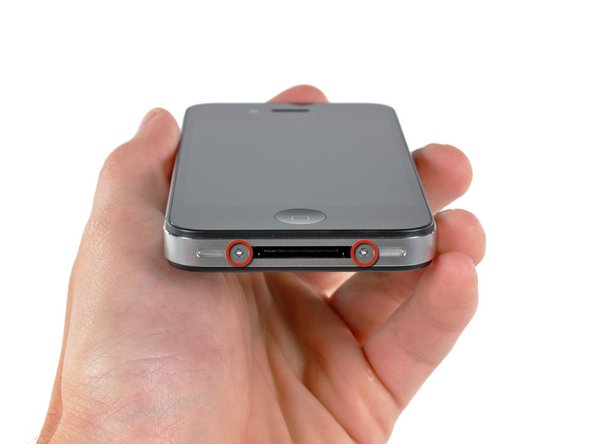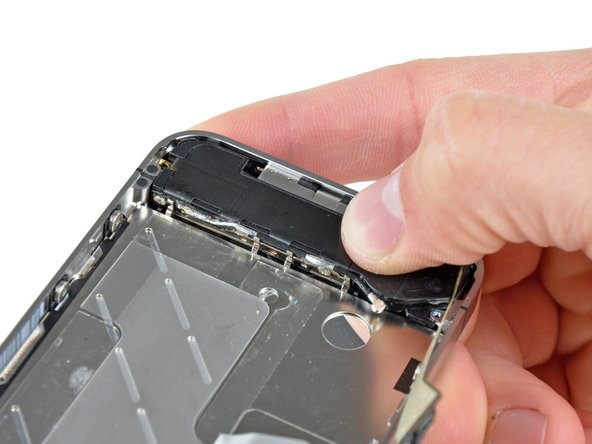Esta versión puede contener ediciones incorrectas. Cambie a la última instantánea verificada.
Qué necesitas
-
-
La caja posterior de tu iPhone 4 puede fijarse bien con dos tornillos Phillips #000 o bien con tornillos Apple de 5-Puntos (segunda imagen). Comprueba cuáles tienes y asegúrate de que tienes el destornillador adecuado para retirarlos.
-
Retira los dos tornillos Pentalobe o Phillips #000 de 3.6 mm que están junto al conector para el cargador.
-
-
-
Remueve el único tornillo de 2.5 mm Phillips que asegura el conector de la batería a la tarjeta lógica.
-
-
-
Usa la pestaña de plástico clara para levantar gentilmente la batería fuera del iPhone.
-
Si hay solución de alcohol restante en el teléfono, límpialo cuidadosamente o permite que se seque antes de instalar la batería nueva.
-
Antes de reconectar el conector de la batería, asegúrate que el clip de contacto (mostrado en rojo) este propiamente posicionado a lado del conector de la batería.
-
-
Este paso está sin traducir. Ayuda a traducirlo
-
Use a SIM card eject tool or a paperclip to eject the SIM card and its holder.
-
Remove the SIM card and its holder.
-
-
Este paso está sin traducir. Ayuda a traducirlo
-
Remove the following two screws:
-
One 1.2 mm Phillips
-
One 1.6 mm Phillips
-
Remove the thin steel dock connector cable cover from the iPhone.
-
-
Este paso está sin traducir. Ayuda a traducirlo
-
Use an iPod opening tool to gently pry the dock cable connector up off the logic board from both short ends of the connector.
-
-
Este paso está sin traducir. Ayuda a traducirlo
-
Carefully peel the dock ribbon cable off the logic board and the lower speaker enclosure.
-
-
Este paso está sin traducir. Ayuda a traducirlo
-
Use a plastic opening tool to pry the lower antenna connector up off its socket on the logic board.
-
-
-
Este paso está sin traducir. Ayuda a traducirlo
-
Remove the 1.9 mm Phillips screw securing the bottom of the logic board to the inner case.
-
-
Este paso está sin traducir. Ayuda a traducirlo
-
Remove the following five screws securing the Wi-Fi antenna to the logic board:
-
One 2.3 mm Phillips
-
Two 1.6 mm Phillips
-
One 1.4 mm Phillips
-
One 4.8 mm Phillips
-
-
-
Utilice una herramienta de apertura de iPod para desprender con cuidado la tapa de la antena Wi-Fi de la tarjeta lógica.
-
Insertar traducción aquí
-
Remueva la antena Wi-Fi del iPhone. Procure no extraviar los clips de metal de la tapa superior donde ajustan los tornillos de 4.8 mm. Esta es la causa por la que regularmente hay fallos en la señal inalámbrica cuando se reensambla.
-
-
Este paso está sin traducir. Ayuda a traducirlo
-
Use the edge of a plastic opening tool to gently pry the following connectors up and out of their sockets on the logic board:
-
Digitizer cable (pry from bottom)
-
LCD cable (pry from bottom)
-
Headphone jack/volume button cable (pry from top)
-
Top Microphone/sleep button cable (pry from top)
-
Front camera cable (pry from top)
-
-
Este paso está sin traducir. Ayuda a traducirlo
-
Remove the 4.8 mm standoff screw near the headphone jack.
-
Without this part, the motherboard could damage the ribbon cables around it.
-
-
Este paso está sin traducir. Ayuda a traducirlo
-
Carefully remove the logic board from the iPhone, minding any cables that may get caught.
-
-
Este paso está sin traducir. Ayuda a traducirlo
-
Remove the single 2.4 mm Phillips screw securing the speaker enclosure to the side of the inner frame.
-
-
Este paso está sin traducir. Ayuda a traducirlo
-
Remove the following two screws securing the vibrator to the inner frame:
-
One 6 mm Phillips
-
One 1.4 mm Phillips
-
Remove the vibrator from the iPhone.
-
-
Este paso está sin traducir. Ayuda a traducirlo
-
Remove the 1.5 mm Phillips screw securing the front panel near the headphone jack.
-
-
Este paso está sin traducir. Ayuda a traducirlo
-
Remove the three large-headed 1.5 mm Phillips screws along the volume button side of the iPhone.
-
-
Este paso está sin traducir. Ayuda a traducirlo
-
Remove the 1.5 mm Phillips screw near the lower microphone.
-
-
Este paso está sin traducir. Ayuda a traducirlo
-
Remove the 1.5 mm Phillips screw near the dock connector ribbon cable.
-
-
Este paso está sin traducir. Ayuda a traducirlo
-
Remove the three large-headed 1.5 mm Phillips screws along the SIM card side of the iPhone.
-
Remove the small-headed 1.5 mm Phillips screw near the rear camera (previously removed).
-
-
Este paso está sin traducir. Ayuda a traducirlo
-
Carefully insert the edge of an iPod opening tool between the rubber bezel around the front glass panel and the steel inner frame.
-
Carefully pry the upper edge of the front panel assembly away from the steel inner frame.
-
-
Este paso está sin traducir. Ayuda a traducirlo
-
Slowly and gently lift the top edge of the front panel assembly away from the steel inner frame.
-
Continue to rotate the front panel assembly away from the steel inner frame until it slowly begins to peel off the adhesive applied below the home button area.
-
It may be easiest to insert a spudger at the top and work it around the edges, spreading gently as you go.
-
Carefully pull the lower edge of the front panel assembly away from the steel inner frame.
-
-
Este paso está sin traducir. Ayuda a traducirlo
-
De-route the digitizer and LCD cables through the steel inner frame, and remove the display from the iPhone.
-
When the front panel has been correctly installed, both the LCD and digitizer cables should be immediately next to one another and should be the same length, as shown in the second photo.
-
During reassembly, do not touch the metallic area at the base of the LCD data cable, as this can cause problems with the LCD. If you do touch it accidentally, clean it gently with an alcohol wipe before continuing.
-
-
Este paso está sin traducir. Ayuda a traducirlo
-
Use the edge of an iPod opening tool or your fingernail to lift the home button ribbon cable retainer.
-
-
Este paso está sin traducir. Ayuda a traducirlo
-
Use a pair of tweezers to pull the home button ribbon cable out of its socket.
-
-
Este paso está sin traducir. Ayuda a traducirlo
-
De-route the home button ribbon cable through the inner case and remove the home button from the iPhone.
-
Cancelar: No complete esta guía.
1675 personas más completaron esta guía.
Documentos Adjuntos
85 comentarios
Utter and complete failure. Followed the directions to a 'T' to replace my home button. Home button works now. Digitizer and screen now only work periodically. Degreased the connections with windex and it only made it worse.
I followed this guide slowly and carefully and it worked perfectly, just used tissue instead of windex and everything is fine, saved me £139 that apple wanted to charge me :)























































